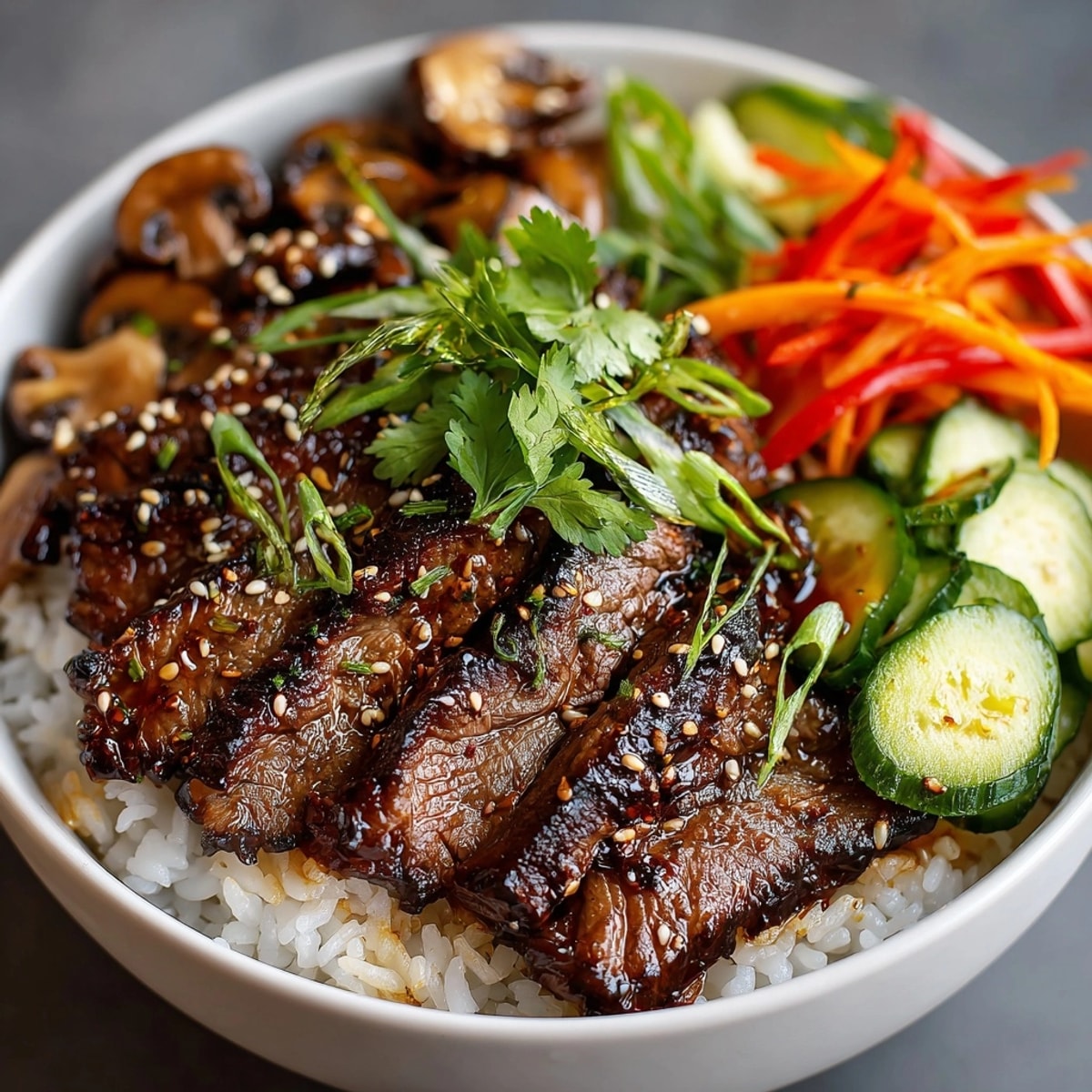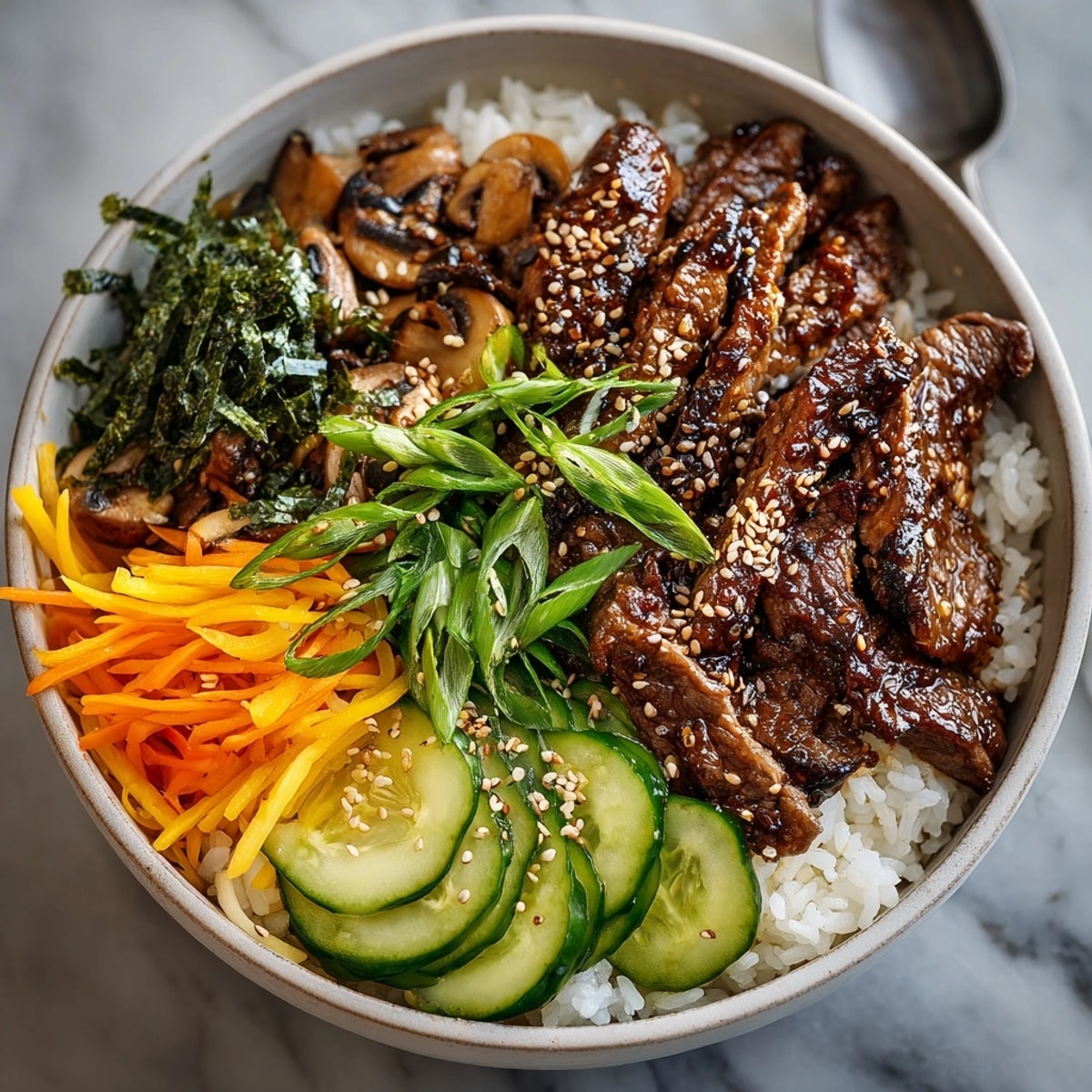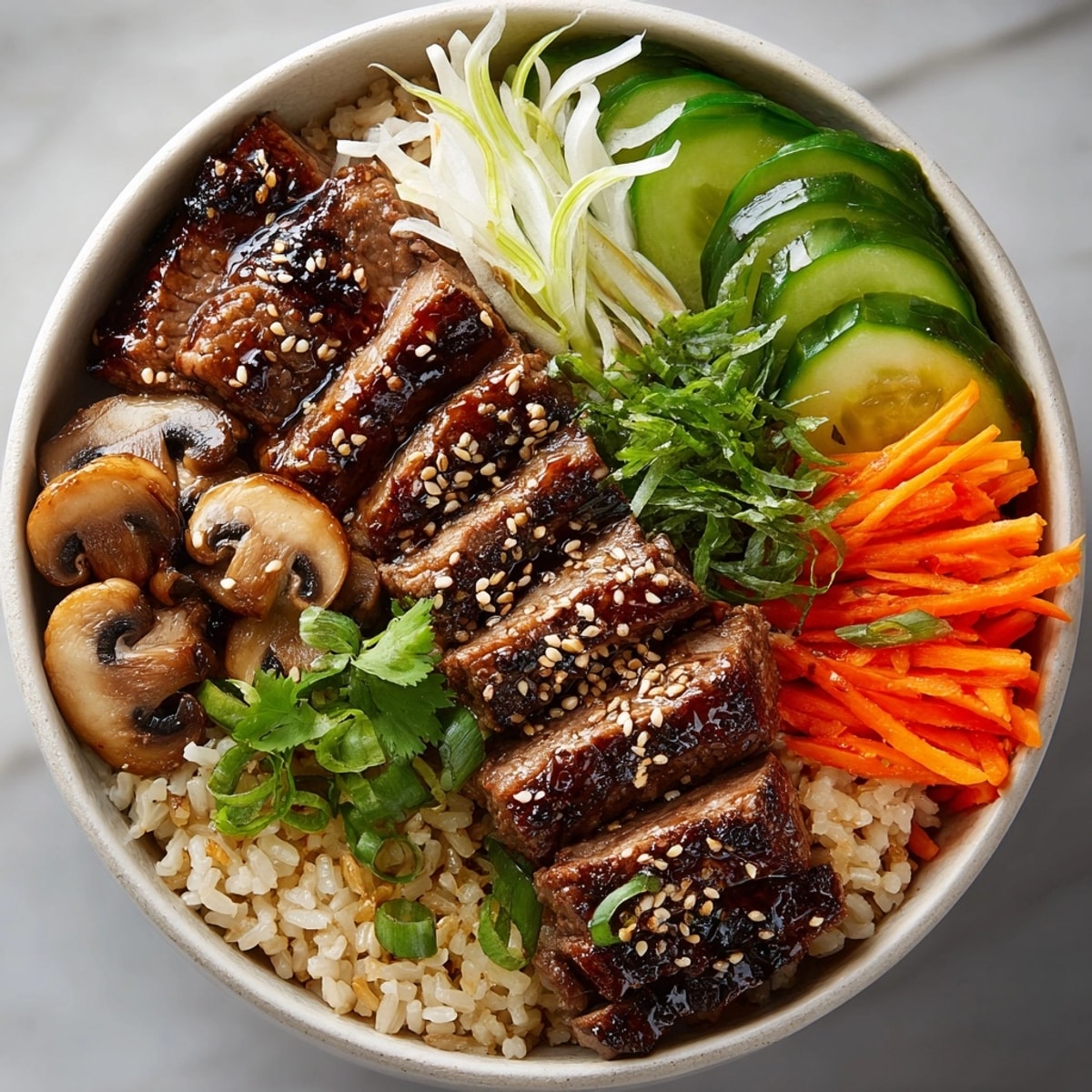 Pin
Pin This hearty Korean BBQ Beef and Mushroom Rice Bowl has become my weeknight dinner hero when I'm craving something satisfying but don't want to order takeout. The combination of tender marinated beef, savory mushrooms, and fresh vegetables creates a perfect balance of flavors and textures that transforms simple ingredients into something truly special.
I first made this dish when I was missing the Korean restaurant near my old apartment. After perfecting the marinade over several attempts, my family now requests these bowls at least twice a month. The combination of tender beef and umami mushrooms never disappoints.
Ingredients
- Flank steak or sirloin: thinly sliced against the grain for maximum tenderness. Look for well marbled cuts for the best flavor.
- Soy sauce: provides the savory foundation for the marinade. Use low sodium if you prefer to control the salt level.
- Sesame oil: adds nutty depth that is essential to authentic Korean flavor. Always use toasted sesame oil for the richest taste.
- Brown sugar: balances the savory elements with subtle sweetness and helps create caramelization when cooking.
- Fresh ginger and garlic: aromatic powerhouses that provide essential flavor complexity. Always use fresh rather than powdered for this dish.
- Gochujang Korean chili paste: brings distinctive sweet heat and umami. Look for it in Asian groceries or the international aisle.
- Cremini or shiitake mushrooms: add meaty texture and earthy flavor. Choose firm mushrooms with dry caps.
- Short grain rice: provides the perfect sticky texture to complement the sauce. Rinse it well before cooking for best results.
- Fresh garnishes: like cucumber, scallions and sesame seeds add brightness, crunch and visual appeal to the finished bowls.
Instructions
- Prepare the marinade:
- Combine soy sauce, sesame oil, brown sugar, ginger, garlic, rice vinegar, gochujang, and black pepper in a medium bowl and whisk thoroughly until the sugar dissolves completely. This balanced mixture creates the perfect flavor foundation for your beef.
- Marinate the beef:
- Add your thinly sliced beef to the marinade, ensuring each piece is well coated. Allow it to marinate for at least 15 minutes at room temperature, or up to one hour in the refrigerator for deeper flavor penetration. The longer marinade time allows the meat to tenderize and absorb all those wonderful flavors.
- Cook the mushrooms:
- Heat a large skillet over medium high heat until hot, then add a small amount of neutral oil. Add your sliced mushrooms in a single layer, allowing them to brown undisturbed for 1 to 2 minutes before stirring. Continue cooking until they release their moisture and become golden brown, about 2 to 3 minutes total. Remove and set aside on a plate. Properly browning the mushrooms develops their rich umami flavor.
- Cook the beef:
- Using the same skillet, add the marinated beef in a single layer, working in batches to avoid overcrowding which would cause the meat to steam rather than sear. Cook for approximately 2 minutes per side until just cooked through with a nice caramelized exterior. Return the mushrooms to the pan and toss everything together for about a minute to meld the flavors.
- Assemble the bowls:
- Divide the warm cooked rice among four serving bowls, creating a base for your toppings. Arrange the beef and mushroom mixture on top of the rice, followed by neat sections of julienned carrots, bean sprouts, and cucumber slices. The contrast of hot cooked elements with cool fresh vegetables creates a pleasing temperature and texture contrast.
- Add final touches:
- Sprinkle each bowl with sliced scallions, sesame seeds, and strips of nori. These finishing elements add color, texture, and additional layers of flavor that elevate the entire dish. Serve immediately while everything is at its peak freshness and temperature.
 Pin
Pin The gochujang is truly the secret weapon in this recipe. I discovered this fermented Korean chili paste years ago and now keep it as a staple in my refrigerator. Its complex sweet heat adds dimension that regular hot sauce simply cannot match. The first time my daughter tried this dish, she immediately asked what made it taste so different from our usual stir fries.
Protein Variations
While beef is traditional and my personal favorite for this recipe, you can easily substitute with other proteins to suit your preferences or what you have available. Thinly sliced chicken thighs work beautifully with the same marinade, though they may need slightly longer cooking time to ensure they're fully cooked through. For a plant based option, extra firm tofu that's been pressed and cubed makes an excellent substitute. Press the tofu for at least 30 minutes before marinating to help it absorb more flavor, and consider adding a tablespoon of cornstarch to help it crisp up when cooking.
Make Ahead Tips
This Korean BBQ bowl is perfect for meal preparation and planning. The marinade can be made up to 3 days in advance and stored in an airtight container in the refrigerator. You can even combine the beef and marinade and freeze it for up to 1 month. Simply thaw in the refrigerator overnight before cooking. The rice can be cooked a day ahead and reheated with a splash of water in the microwave. Fresh vegetables should be prepared just before serving for the best texture and flavor, though carrots can be julienned a day ahead and stored in cold water in the refrigerator to maintain crispness.
Serving Suggestions
For a complete Korean inspired meal, serve these rice bowls with traditional banchan small side dishes. Quick kimchi, pickled daikon, or a simple cucumber salad dressed with rice vinegar and a touch of sugar make excellent accompaniments. For a refreshing beverage pairing, try cold barley tea or a light lager beer which complements the savory flavors without overwhelming them. If serving for guests, consider setting up a DIY bowl bar where everyone can assemble their own bowls with their preferred toppings. This interactive approach makes for a fun dining experience and accommodates different preferences.
Cultural Context
This recipe draws inspiration from traditional Korean Bulgogi beef but transforms it into a convenient rice bowl format. Bibimbap, which means mixed rice in Korean, is the traditional inspiration for this dish where various ingredients are arranged over rice. Traditionally, bibimbap is served with gochujang on the side and sometimes in a hot stone bowl called dolsot that creates a crispy rice crust. While this version is simplified for home cooking, it maintains the key flavor profiles that make Korean cuisine so beloved its perfect balance of sweet, savory, spicy, and umami elements, along with contrasting textures and temperatures.
 Pin
Pin These Korean BBQ Beef and Mushroom Rice Bowls are a delicious and satisfying meal that can be enjoyed any night of the week. The easy preparation and customizable ingredients make it a go-to for busy home cooks.
Recipe Q&A
- → How thinly should the beef be sliced?
Slice beef against the grain into thin strips, about 1/4 inch thick, for the most tender bite and quick, even cooking.
- → Can different mushrooms be used?
Yes, substitute cremini or shiitake with oyster or enoki mushrooms for a different texture and flavor profile.
- → Is this dish spicy?
The gochujang adds subtle heat. For a spicier bowl, increase gochujang or add sliced fresh chili to taste.
- → How can I make this gluten-free?
Use tamari instead of soy sauce and ensure your gochujang is labeled gluten-free. Always check ingredient labels.
- → What are ideal garnishes?
Top with thin cucumber slices, nori strips, fresh cilantro or perilla leaves, and a sprinkle of toasted sesame seeds for extra flavor and crunch.
- → What rice works best?
Short-grain rice is traditional, but jasmine rice also works well for lightness and aroma.

